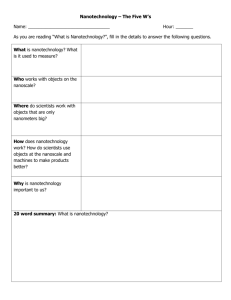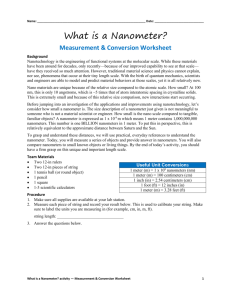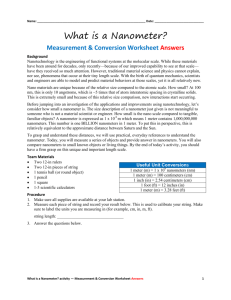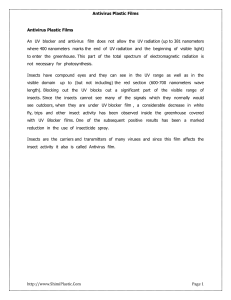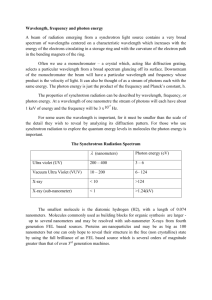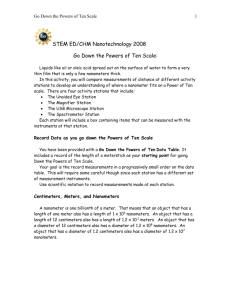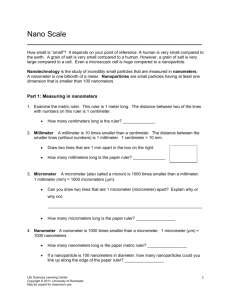How small is a nanometer?
advertisement
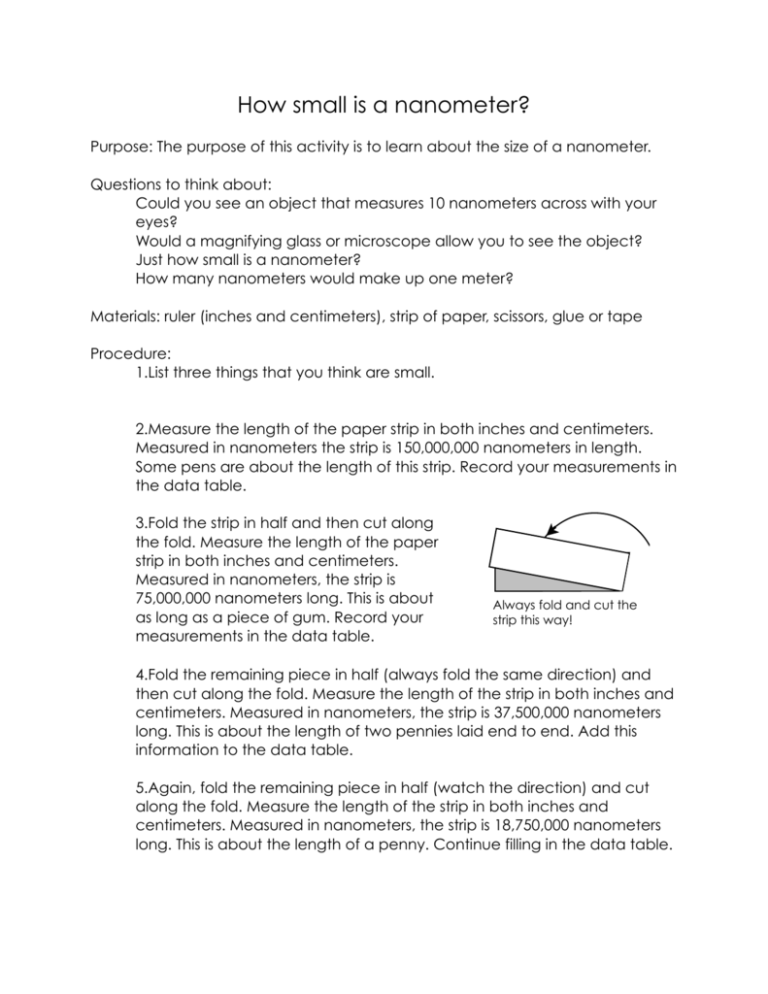
How small is a nanometer? Purpose: The purpose of this activity is to learn about the size of a nanometer. Questions to think about: Could you see an object that measures 10 nanometers across with your eyes? Would a magnifying glass or microscope allow you to see the object? Just how small is a nanometer? How many nanometers would make up one meter? Materials: ruler (inches and centimeters), strip of paper, scissors, glue or tape Procedure: 1.List three things that you think are small. 2.Measure the length of the paper strip in both inches and centimeters. Measured in nanometers the strip is 150,000,000 nanometers in length. Some pens are about the length of this strip. Record your measurements in the data table. 3.Fold the strip in half and then cut along the fold. Measure the length of the paper strip in both inches and centimeters. Measured in nanometers, the strip is 75,000,000 nanometers long. This is about as long as a piece of gum. Record your measurements in the data table. ! Always fold and cut the strip this way! 4.Fold the remaining piece in half (always fold the same direction) and then cut along the fold. Measure the length of the strip in both inches and centimeters. Measured in nanometers, the strip is 37,500,000 nanometers long. This is about the length of two pennies laid end to end. Add this information to the data table. 5.Again, fold the remaining piece in half (watch the direction) and cut along the fold. Measure the length of the strip in both inches and centimeters. Measured in nanometers, the strip is 18,750,000 nanometers long. This is about the length of a penny. Continue filling in the data table. 6.One more time - fold the remaining piece in half (don’t change direction) and then cut along the fold. Measure the length of the paper strip in both inches and centimeters. In nanometers, the strip is 9,375,000 nanometers long. This is about the width of your little finger. Add this information to the data table. 7.Cut the remaining piece in half (watch the direction). Measure the length of the paper strip in both inches and centimeters. Measured in nanometers, the strip is 4,687,500 nanometers long. This is about the height of the eraser on your pencil. Complete the data table. 8.You should be able to cut the remaining piece in half one more time. Measure the length of the paper strip in both inches and centimeters. Measured in nanometers, the strip is 2,3,43,750 nanometers across. This is about the size of the head of a pin. Complete the data table. Number of cuts Length (in) Length (cm) Length (nm) 0 1 2 3 4 5 6 Summing Up: 1.How many more times do you think you could cut each remaining piece in half? 2.It would take a total of 24 cuts to get a piece 10 nanometers long. Is this pair of scissors the right size tool to use for this job? Explain. 3.The width of a human hair is about 80,000 nanometers. Write 80,000 in word form. 4.Our red blood cells are about eight thousand nanometers in diameter. Write eight thousand in number form. 5.Some cell membranes are 10nm thick. Could you see the thickness of a cell membrane with your eyes or a magnifying glass? 6.The prefix nano means one-billionth. A nanometer is one-billionth of a meter. That means there are one billion nanometers in a meter. Write one billion in number form. 7.Look back at the three things you considered to be small. Describe how your ideas about small have been changed today. What is a nanometer? Scientists use the metric system to make measurements. Lengths are measured in meters. A meter can be divided into 10 parts called decimeters or 100 parts called centimeters or even 1,000 parts called millimeters. The meter can be divided into even smaller parts. Nano- is a metric prefix meaning one-billionth. There are one billion (1,000,000,000) nanometers in a meter. Follow the directions on the sheet called What is the length of your hand? to measure your hand in nanometers. Set an open bottle of mint extract on a table. Wait a minute. What happens? Can you smell the mint? Do you see the mint molecules? Even though you cannot see the molecules, you can smell them. The molecules have moved out of the bottle and around the room coming into contact with your nose. You infer their presence because you observed the smell. Just because we can’t see molecules doesn’t mean their size can’t be described. The size of molecules is expressed in nanometers. A sucrose molecule1 measures about 1 nanometer (nm) across. A grain of sucrose measures about 500,000 nm across. There are many, many sucrose molecules in each grain! A nanometer is incredibly small! We cannot see molecules with magnifying glasses or normal microscopes. It became easier to study matter at the molecular level once we could image it. Special machines called scanning tunneling microscopes and atomic force microscopes are used to image molecules. These machines were invented less than fifty years ago. Although we think of nanotechnology as a new area of science, nano ideas have been around a long time. Medieval glass artists used nano-sized particles of gold and silver to create beautiful colored glass for stained glass windows. The glassmakers did not know they were using a type of nanotechnology. But they knew what process to use to create the colors of glass they wanted. Today we think of nanotechnology as the study of and manipulation of objects that measure between 1 and 100 nanometers. This is the size of molecules. Scientists have learned how to make changes at the molecular level to enhance consumer products. Today nanotechnology is used to make clothes 1 sucrose is the sugar you use on breakfast cereal that don’t stain, better drug delivery systems and smaller components for our cell phones and computers. To learn more about the size of a nanometer and nanotechnology watch these two videos: How Small Is Nano? found at http://www.youtube.com/watch? v=bQzFpP4FSN4 The strange new world of nanotechnology located at http:// www.nanowerk.com/news/newsid=16048.php Questions: 1.A tall basketball player could be about 2 meters tall. How many centimeters are in 2 meters? 2.What does the prefix nano- mean? 3.How many nanometers are in 1 meter? 4.How long is your hand when measured in nanometers? 5.How do you know mint molecules come out of the open bottle of extract? 6.Although we can’t see molecules, give one example of why we know they exist? 7.What is the common name for sucrose? 8.Why do we think of nanotechnology as something new? 9.Name one machine used to image molecules. 10.Define nanotechnology as defined in this article. 11.List four things you learned by watching the videos. What is the length of your hand? Place the heal of your hand on the zero mark near the bottom of this page. What is the length of your hand in nanometers? 200 million nanometers 190 million nanometers 180 million nanometers 170 million nanometers 160 million nanometers 150 million nanometers 140 million nanometers 130 million nanometers 120 million nanometers 110 million nanometers 100 million nanometers 90 million nanometers 80 million nanometers 70 million nanometers 60 million nanometers 50 million nanometers 40 million nanometers 30 million nanometers 20 million nanometers 10 million nanometers 0 million nanometers

